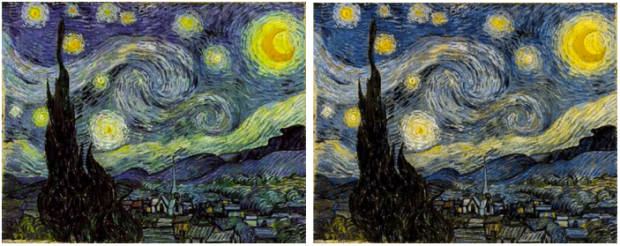After a chat with his color deficient friends about how Vincent van Gogh’s paintings seem to appeal to all eyes, Kazunori Asada used visual filters to see how the paintings looked to the colorblind. The experiment produced some interesting results and musings:
Was van Gogh partially color vision deficiency (anomalous trichromat)? Perhaps using a strong color vision deficiency (dichromat) simulation was the wrong approach. How about carrying out the simulation by removing the middle portion of normal color vision, maybe then I could see van Gogh’s pictures in a better light?
The color choices for van Gogh’s popular paintings seem less out there with the filters. The greens in the sky of Starry Night, for example turn to yellows.
A colorblind van Gogh though? Probably not. Either way, don’t forget to pick your colors wisely. Asada has an easy-to-use tool to see what your own images look like to others.



An easier-to-use tool than that linked above: http://michelf.com/projects/sim-daltonism/
Inward processes stand in need of outward criteria. this is a good example of the ambiguity in the phrase ‘what is looks like to me’.
I didnt quite understand the article through the jargon – I’m colorblind (red/green) and the two pictures above look the same to me. Do they look the same to others? In fact, all of the paintings on the page looked basically the same to me. Was that the point?
They’re all different. The one on the left is how non-colorblind see it and the one on the left is how you see it. The main question was a wondering if van Gogh might have had some colorblindness because of his color choices.
very interesting – thanks for the insights
i think you meant to say that “The one on the left is how non-colorblind people see it and the one on the *right* is how non-colorblind people can see it like a colorblind person might see it.”
An even easier tool than the two previous: (free Windows / Linux / Mac) http://colororacle.org/